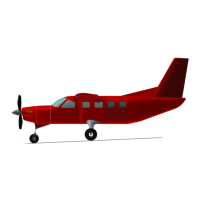LANDING EMERGENCIES
Forced Landings
If all attempts to restart the engine fail and a forced landing is imminent,
choose a suitable landing area and prepare for the landing as outlined in the
Engine-Out Emergency Landing checklist.
Prior to executing an “off airport” landing with engine power available, y
over the landing area at a safe but low altitude and inspect the terrain for
obstructions and undesirable surface conditions. Proceed as outlined in the
Powered Precautionary Landing checklist.
Ditching
For ditching (performing an emergency water landing), if possible, secure
or jettison heavy objects located in the cabin or baggage areas and collect
folded coats, or other padded objects, for face protection at touchdown.
Transmit a Mayday message on 121.5 MHz providing the location and
intentions and Squawk 7700. At night, avoid aring the aircraft because of
possible difculty in judging the aircraft’s height above water surfaces.
Jammed or Disconnected Rudder
The airplane can be safely controlled to a landing by using ailerons to turn
the airplane. If possible, avoid crosswinds and select a wide runway to
compensate for any drift with crosswind. Ground control after landing can be
maintained using differential braking.
Jammed or Disconnected Ailerons
The airplane can be safely controlled to a landing by using the rudder to
turn the airplane. Maximum ap deection of 20° is recommended for better
responsiveness. If possible, limit the maximum bank angle to 15° and avoid
crosswinds. Select a wide runway to compensate for any drift with crosswind.
Loss of Elevator Control
Use engine power and elevator trim to produce a long shallow approach, at
approximately 300 feet per minute descent, with 20° of aps and 85 KIAS.
Control the glide path by adjusting the engine power, and use small trim
adjustments to control airspeed.
The landing are can be accomplished with a gentle reduction of power,
accompanied by nose-up trim. With forward C.G. loadings, it may be
necessary to increase the power slightly in the nal portion of the are to bring
the nose up and prevent a nose-rst landing. Following touchdown, move the
power lever to IDLE.
NOTE: The overhead fuel selector valve handles control the fuel shutoff
valves at the outlets of the fuel tanks. To minimize re hazards, these
selectors should be turned OFF during the nal stages of an “off airport”
approach to landing. With the fuel selectors turned OFF, there will be
sufcient fuel in the reservoir tank for approximately 3 minutes of maximum
continuous power, or approximately 9 minutes of operation at idle power.
WARNING: If the precautionary landing is aborted, return the fuel tank
selectors to the ON position while initiating the Go-Around.

